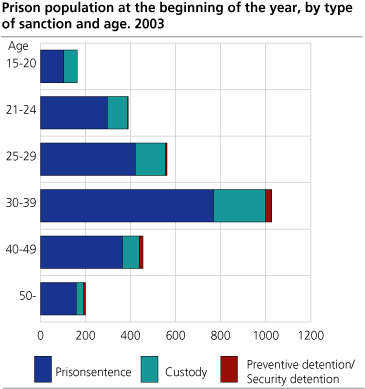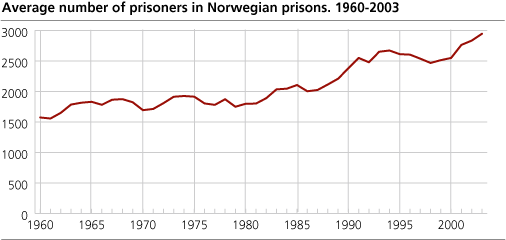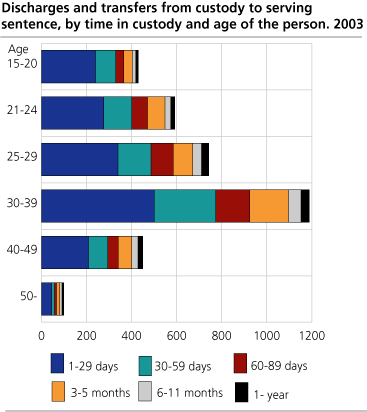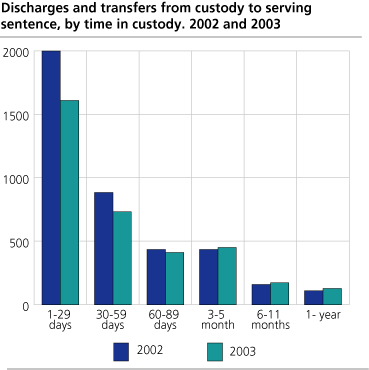Content
Published:
This is an archived release.
More prisoners in jail - fewer imprisoned
On average, there were 2 944 prisoners in 2003, which indicate that more than one million days were spent in Norwegian prisons. This is an increase of 4 per cent from the previous year and 900 more prisoners than twenty years ago. More were imprisoned on prison-sentence and preventive detention/ security detention, but fewer in custody and serving sentence for non-payment of a fine. There were less short imprisonments into custody, for offences of narcotics in particular.
More serving a sentence
On an average day in 2003, 2 194 persons were serving prison-sentences, 69 preventive detention/ security detention, 644 were in custody, and 38 were serving sentence for non-payment of a fine. Those convicted to imprisonment make, in other words, 77 per cent of all prisoners. Compared to the previous year there are 7 per cent more serving prison-sentences and 8 per cent more on preventive detention/ security detention. On the other hand, the average number of custody prisoners decreased by 3 per cent, and persons serving sentences for non-payment of a fine by 27 per cent.
The distribution by sex, age and offence of the prison population at the beginning of the year, was about the same as in 2002 and 2003. Narcotic crimes were principal offence for 27 per cent of all prisoners, theft for 19 per cent, 14 per cent for crimes of violence against persons - the same shares as inthe previous year. 1 January 2003, 34 per cent of the prisoners were in the age group 21-29 years and 36 per cent in the age group 30-39 years. The youngest age groups have the largest share of prisoners in custody: Every third under the age of 21, and every sixth over the age of 50, were in custody at the beginning of the year (see figure).
More new imprisonments, especially into custody
Despite more prisoners in Norwegian prisons, the statistics on imprisonments indicate a decrease in number of imprisonments during the last two years. In 2003, the prisons received just short of 10 700 new imprisonments, which is 8 per cent less than the previous year - and 11 per cent less than in 2001.
The decrease from 2002 to 2003 is due to fewer imprisonments into custody and serving a sentence for non-payment of a fine - by 21 and 41 per cent, respectively. The decrease in custody imprisonments applies to all age groups and both sexes. Imprisonment into custody is more rarely used for most types of offences, but the total decrease is mostly due to the reduction of imprisonments into custody because of narcotic crimes: In total there were 845 fewer imprisonments into custody, and 342 fewer imprisonments into custody with narcotics as the principal offence.
In 2003, there were 2 339 discharges from custody and 1 162 transfers from custody to serving a sentence. 61 per cent of the discharges, and 15 per cent of the transfers, happened after a shorter than one month stay in custody. Of all those completed custody in 2003, 38 per cent were in the age group 21-29 years and 34 per cent 30-39 years (see figure). The number of short imprisonments into custody is reduced. 19 per cent less had been in custody under 2 months compared to the previous year. The number of those spending a longer time in custody, is, however, unchanged. For example, 128 persons completed their stay in custody of longer than a year, compared to 110 in 2002 (see figure).
|
New special sanctions
The new special sanctions preventive detention, compulsory mental health care and compulsory care entered into force 1 January 2002 and was made retrospective so that security detention sentences can be reopened and reversed to one of the new special sanctions. The special sanctions replaced security detention as special penal measure, but there will still be persons serving sentences with warrant in security detention sanctions. In 2003 there were 3 new imprisonments and 15 transfers from custody to serving new preventive detention sentences. |
Tables
Contact
-
Susanne Fjelldalen
E-mail: susanne.fjelldalen@ssb.no
tel.: (+47) 40 90 26 43
-
Kristin Bergvall
E-mail: kristin.bergvall@ssb.no
tel.: (+47) 92 66 55 13
-
Reid Jone Stene
E-mail: reid.jone.stene@ssb.no
tel.: (+47) 99 02 22 01




